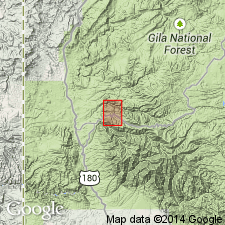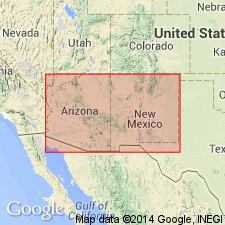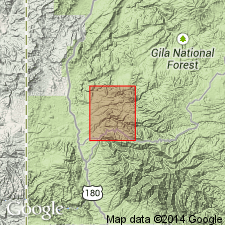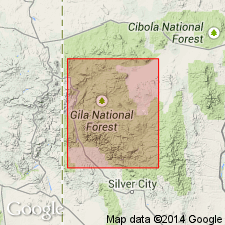
- Usage in publication:
-
- Whitewater Creek rhyolite*
- Modifications:
-
- Original reference
- AAPG geologic province:
-
- Basin-and-Range province
Summary:
Whitewater Creek rhyolite. Light purple; breaks with platy fracture. Several flows and beds of white tuff mark periods of explosive activity. Thickness 700+/- feet. [Present in Mogollon district, New Mexico.] Oldest formation in district. Age is Tertiary.
Named from exposures in steep canyons along lower reaches of Whitewater and Mineral Creeks, Mogollon district, NM.
Source: US geologic names lexicon (USGS Bull. 896, p. 2327).

- Usage in publication:
-
- Whitewater Formation
- Modifications:
-
- Paleomagnetics
- AAPG geologic province:
-
- Basin-and-Range province
Summary:
In a section measured at Mogollon, Catron Co, NM, Basin-and-Range province, detailed magnetic studies reveal a simple pattern: Cooney Formation and Whitewater Formation [author is referring to Whitewater Creek Member of Cooney Tuff] are older than the other units (Bikerman, 1972), and they are consistently reversely magnetized. They are overlain by Pacific Quartz Latite, which correlates approximately with Apache Spring Quartz Latite. Pacific Quartz Latite is very stable magnetically, but it has an unusual direction of magnetization--therefore, it probably cooled rapidly during a time when the field was reversing. Both in its direction of magnetization and in its magnetic properties, Pacific bears a surprising similarity to Taylor Creek Rhyolite, but is distinctly older. Magnetostratigraphic position of Whitewater, Cooney, and Apache Spring units within a preliminary model of the middle Tertiary paleomagnetic reversal pattern is depicted on fig. 5.
Source: GNU records (USGS DDS-6; Denver GNULEX).

- Usage in publication:
-
- Whitewater Creek Member*
- Modifications:
-
- Revised
- Geochronologic dating
- AAPG geologic province:
-
- Basin-and-Range province
Summary:
Type locality designated as in SE1/4 sec 6, T11S, R19W, Catron Co, NM, Basin-and-Range province. As basal member of Cooney Tuff underlies Cooney Canyon Member (new) of Cooney. Is a rhyolitic ash-flow tuff, a simple cooling unit, 160 m thick. Has a Zr F-T age of 31.8 +/-2.8 m.y.; assigned to Oligocene.
Source: GNU records (USGS DDS-6; Denver GNULEX).

- Usage in publication:
-
- Whitewater Creek Member*
- Modifications:
-
- Geochronologic dating
- AAPG geologic province:
-
- Basin-and-Range province
Summary:
Has yielded a 31.8 +/-2.8 m.y. age (zircon), [or Oligocene]. Sampled in the Basin-and-Range province.
Source: GNU records (USGS DDS-6; Denver GNULEX).
For more information, please contact Nancy Stamm, Geologic Names Committee Secretary.
Asterisk (*) indicates published by U.S. Geological Survey authors.
"No current usage" (†) implies that a name has been abandoned or has fallen into disuse. Former usage and, if known, replacement name given in parentheses ( ).
Slash (/) indicates name conflicts with nomenclatural guidelines (CSN, 1933; ACSN, 1961, 1970; NACSN, 1983, 2005, 2021). May be explained within brackets ([ ]).

